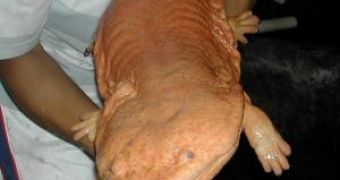This top comprises animals you may have never heard about. EDGE (Evolutionarily Distinct and Globally Endangered) comprises animal species evolutionarily isolated. Most of them are extremely endangered (in fact, even their vulnerability makes the group or the sole species isolated from other lineages) and require rapid protection. A formula combining each species' unique evolutionary history with its status delivers an EDGE rank.
A top 100 EDGE mammal species was made in January 2007. Now a top 100 EDGE amphibian species (frogs, salamanders and caecilians) has been made, and not surprisingly, 85 of these 100 species have no solid conservation status.
"The EDGE amphibians are amongst the most remarkable and unusual species on the planet and yet an alarming 85% of the top 100 are receiving little or no conservation attention and will become extinct if action is not taken now. These animals may not be cute and cuddly, but hopefully their weird looks and bizarre behaviors will inspire people to support their conservation," said Helen Meredith, EDGE Amphibians coordinator.
These are some of the world's most extraordinary amphibians currently threatened with extinction:
1. Chinese giant salamander (Andrias davidianus) can grow up to 1.8m in length and it's the world largest living amphibian. Its group evolved far before the evolution of dinosaurs. Hellbender of the Allegheny Mountains is related to it.
2. Sagalla caecilian is a worm-like limbless amphibian with sensory tentacles on the sides of its head discovered living in a small area in Kenya in 2003
3. Purple frog was discovered in 2003 because it spends most of the year at 4m (13 ft) underground, going out only during the monsoon. It inhabits southern India.
4. Ghost frogs in South Africa (one species is found only in the traditional human burial grounds of Skeleton Gorge in Table Mountain, South Africa)
5. Olm or proteus is a blind salamander with translucent skin inhabiting caves in Slovenia and Croatia. The animal uses smell and electrosensitivity to detect prey and can survive 10 years without food. It lives up to 58 years, an enormous lifespan for such a small creature!
6. Lungless salamanders inhabit the tropical forests of the Americas; they lack lungs, breathing through their skin and mouth lining. Many species are endangered.
7. Malagasy rainbow frog is a vividly colored species that inflates itself when attacked and can climb vertical rock surfaces; it is one of the rarest amphibian species.
8. Darwin's frogs (2 species) live in Chile. The male incubates the eggs in his mouth spitting out froglets. One species has not been seen since 1980.
9. Betic midwife toad belongs to a group of Anurans over 150million years old. The males transport the fertilized eggs in clusters around their hind legs.
For the gastric-brooding frogs, the EDGE top may have come too late. These remarkable Australian frogs could be extinct. They are known for the female's ability to incubate the eggs in her stomach. A research on these species could have been solved many problems of human stomach ulcer.
"Tragically, amphibians tend to be the overlooked members of the animal kingdom, even though one in every three amphibian species is currently threatened with extinction, a far higher proportion than that of bird or mammal species. These species are the 'canaries in the coalmine' - they are highly sensitive to factors such as climate change and pollution, which lead to extinction, and are a stark warning of things to come. If we lose them, other species will inevitably follow. The EDGE program strives to protect the world's forgotten species and ensure that the weirdest species survive the current extinction crisis and astound future generations with their extraordinary uniqueness," said Dr Jonathan Baillie, Head of the EDGE program.
Amphibians are threatened by habitat loss, poaching, overexploitation, pollution, climate change and disease (especially the chytrid fungus, involved in mass mortality worldwide).

 14 DAY TRIAL //
14 DAY TRIAL //